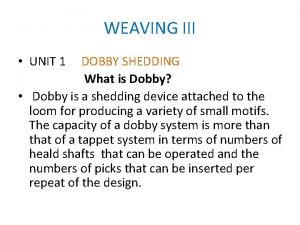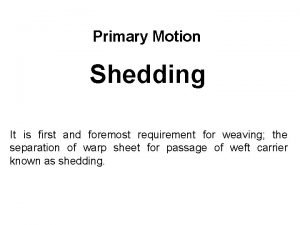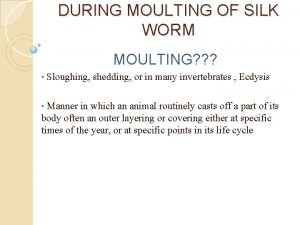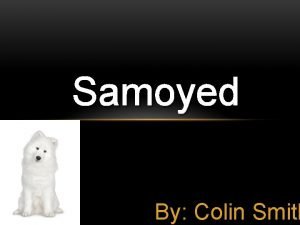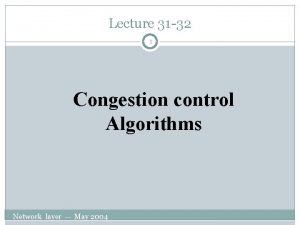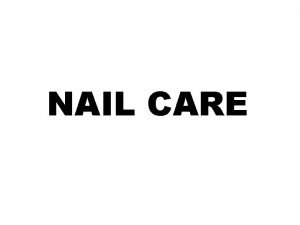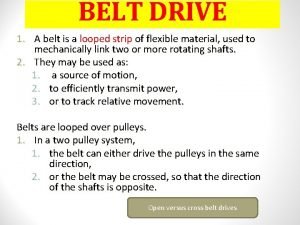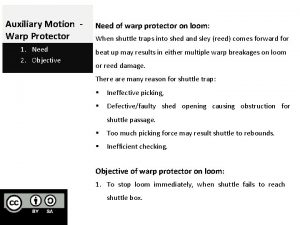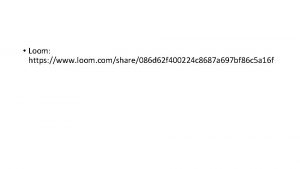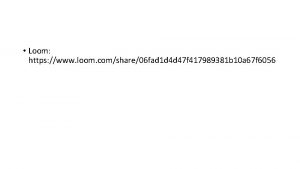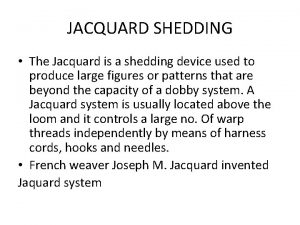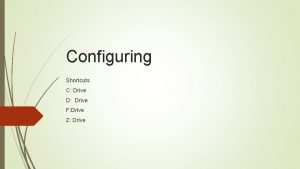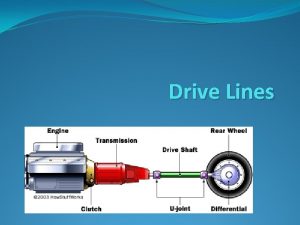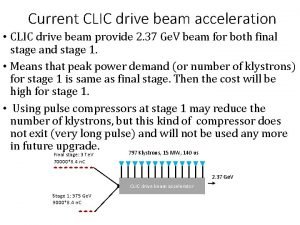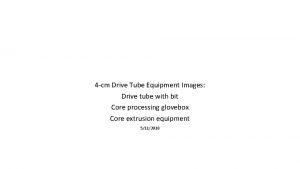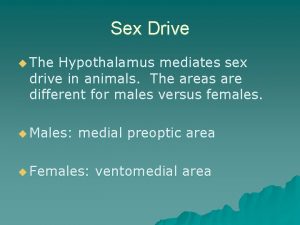L3 Shedding Mechanism of Loom v Loom Drive



























- Slides: 27

L-3, Shedding Mechanism of Loom v. Loom Drive Ø Loom is driven by motor Ø Motor pulley is engaged with crank shaft pulley with belt Ø Crank shaft gear engaged with bottom shaft gear Ø Crank gear teeth: bottom shaft gear teeth is 1: 2 Ø Crank shaft rpm : bottom shaft rpm is 2: 1 Note: for drive , go through the fig in study material 10/25/2021 AKSGangwar 1

• Crank shaft rpm = picks per minute =speed is the loom ü Crank rpm =motor rpm X (motor pulley dia / Loom pulley dia) ü Bottom shaft rpm = crank shaft rpm X (Crank gear teeth / bottom shaft gear teeth) Ø Loom Timings: • Rotation of crank is divided in four angular groups • 0 o→ Top, 90 o→ Front, 180 o→ Bottom, 270 o→ Back 10/25/2021 AKSGangwar 2

Shedding v. Object: division of single layer of warp sheet in to two layer is known as shedding v. Sheds are formed with the help of heald shafts v. There are three shedding mechanismsv. Tappet v. Dobby v. Jacquard 10/25/2021 AKSGangwar 3

Type of sheds v. Open sheds: Ø In fully opened shed, the shed is always in open position Ø Two stationary lines are formed (one at top & other on bottom) Ø after insertion of pick, threads from top position comes lower at a centre position and threads of bottom position raised to that centre position 10/25/2021 AKSGangwar 4

Ø In semi open shed, a stationary bottom line is retained. Ø The top line is movable one. Ø After insertion of pick, the top line moves towards the bottom line. v. Closed Sheds: Ø Shed closes after insertion of pick • In centre close shed, warp threads move in upward & downward direction from a centre line. • Both the lines meet at the centre line after insertion of pick 10/25/2021 AKSGangwar 5

Ø Bottom closed shed: Ø This is formed by giving motion to only those threads that form the top line Ø After insertion of pick, all warp threads come to the bottom line 10/25/2021 AKSGangwar 6

• These are two types: • Positive: in this tappets control upward & downward movements of heald (Ref: see the tappet in study material) • Negative: If tappet controls only one way movement of healds either in upward or downward movement of healds. • Heald shafts are returnrd by the external devices like dead weight, roller, springs etc. 10/25/2021 AKSGangwar 7

Negative Tappet Shedding Mechanism Construction 10/25/2021 AKSGangwar 8

Timings and Setting: • Turn the crank to the top centre position. • Fix the anti-friction bowls to the treadle levers; they should move freely in the slots. • Fix the treadle levers with a bracket to the back rail of the loom. • Set the grid and grid bracket to the front rail of the loom in the slots of the grid. • Make sure that the tappet with the lower throw is fixed to the bottom shaft at the starting handle side. 10/25/2021 AKSGangwar 9

• Fix the top reversing rollers to the top reversing roller shaft to be equidistant from the ends and at the same time ensure that the connecting screws of the rollers are symmetrical about the central axis of the shaft when the heald shafts are at the same level. The roller of smaller diameter is always connected to front heald shaft. • The heald shafts are connected to the top reversing rollers by means of cords and leather straps. The leather straps are connected to the rollers, such that when one of them winds on its roller the other strap unwinds from its roller and vice versa. • Lamb rods are connected to the heald shafts by cords. • Adjust the tappets on the bottom shaft and make sure of the following points: 10/25/2021 AKSGangwar 10

Advantages and Disadvantages of Tappet Shedding: • Advantages: • It is robust, simple and cheap • It is capable of lifting a heavy weight with less wear and tear than other shedding mechanisms. • It can move heald shafts at great speeds. • It puts less strain upon the warp. • It consumes less power and gives greater output. • It requires less maintenance 10/25/2021 AKSGangwar 11

Disadvantages: • If the weave is changed, it will be necessary to change the tappet and the change gear wheel in the counter shaft arrangement. • So work involved in changing the weave is more. • The capacity of a tappet to produce a pattern / weave is very much limited. A maximum of 8 or 10 tappets only can be used. 10/25/2021 AKSGangwar 12

Dobby Shedding • This is a compact, electronically guided shedding motion and capable of having up to 28 shafts. More complex and versatile shedding motion. A dobby loom, therefore, can have up to 28 shafts, and much greater weave repeat is possible. Design may be woven with two or more basic weaves and their variation. Such fabrics may be referred as dobby cloths or dobby weave, towels usually show geometric designs when pattern is provided by dobby. 10/25/2021 AKSGangwar 13

Principle of Negative Dobby Shedding: • In this type of shed, lowering of the heald frame occurred mechanically. • Construction: • In the negative shedding the heald frames are operated by the jack & lever. • The levers are connected with the knife and the knifes are attached with the driving rod by means of connecting needle. • A pattern is used here according to the weave plan. When the teeth of chain is come to the contact of chain drum then whole the arrangement moves together and lowering of the heald frame is occurred by the spring. 10/25/2021 AKSGangwar 14

Working Principle: • The lowering of the heald frame is happens here by spring or jack lever. • When the pattern cylinder doesn’t find peg on the pattern drum then bauck lever and jack lever bring the heald frame in downward direction, • therefore the lowering of the heald frame is occurred by means of spring tension. 10/25/2021 AKSGangwar 15

10/25/2021 AKSGangwar 16

• Advantages of Negative Dobby: • Highly complex and critical fabrics can be weaved. • At a time it can control many heald frame • Faste than the positive dobby as well as over conventional loom • Can produce close bottom shed 10/25/2021 AKSGangwar 17

• Disadvantages of Negative Dobby: • In this shed only lowering of the shed is possible Due to more stress, yarn breakages more • It is not good for heavier fabric • It does not provide more high speed to the loom 10/25/2021 AKSGangwar 18

• Positive Dobby Shedding • Principles of positive dobby • In this type of shed lifting & lowering of the heald frame both is possible. • Lifting is occurred by means of jack & lever • lowering is occurred by means of spring under tension. 10/25/2021 AKSGangwar 19

• Construction and Working Principle: • Positive dobby shedding is the combination of three Cylinders, jack lever, spring and a shaft • Between the three cylinders a shaft is fulcrum in one side the upper cylinder moves as the anti clockwise and lower cylinder moves as the clock wise direction • The main cylinder when get motion from the shaft when it found peg or pattern plan the cylinder attached with the upper half toothed disc 10/25/2021 AKSGangwar 20

• So that the heald frame is up & when the pattern cylinder doesn’t found peg then the main cylinder attached with the lower half toothed disc • and the spring retains the heald frame to the downward direction 10/25/2021 AKSGangwar 21

Jacquard Shedding: • To provide with unlimited design width, jacquard shedding is needed • This shedding motion has no shafts, instead, a hardness consisting of as many cords as there are ends in the warp sheet connects each end individually to the jacquard machine • Each warp could weave independently of all others. Complex and most versatile shedding motion • Biggest weave is possible with jacquard shedding as each warp yarn may be individually controlled. 10/25/2021 AKSGangwar 22

• A Jacquard attachment has blades, hooks, needles, a griffe, griffe hooks, and a perforated cylinder • The warp strands, drawn through the heddle eyes, are tied to the loom by harness cords, which are threaded through a comber board for even distribution over the width of the loom • The blades set in a blade frame, move up and down. The hooks that are near the blades are engaged by them and lifted up, and the warp strands are also lifted by the griffe hooks and harness cords to form the upper part of the shed (the warp yarn in the fabric) • Hooks that are out of reach of the blades drop, together with the griffe. The hooks and the warp strands drop because they are attached to weights • The lowered strands of the warp yarn form the lower part of the shed (the woof yarn in the fabric) 10/25/2021 AKSGangwar 23

• The hooks coming from the area of the blades’ action are drawn out by needles activated by the cylinder, which in turn has a rocking and rotating motion • A piece of cardboard consisting of individual paper cards is placed on the cylinder • These cards have perforations, and when a needle comes to a perforation it enters the cylinder and the hook stays near the blade, but when a needle does not meet a perforation it is pushed back and the hook is kept away from the knife • By combining perforated and un perforated places on the cards it is possible to exercise complete control over the raising and lowering of warp strands and to form a design on the fabric. 10/25/2021 AKSGangwar 24

10/25/2021 AKSGangwar 25

• Advantages of Jacquard Shedding • Jacquard shedding mechanisms are capable of producing large and intricate weave designs that are beyond the scope of dobby shedding mechanisms • In jacquard weaving, it is possible to control every warp yarn individually • Many specialized types of jacquard machine have been developed for weaving particular kinds of fabric, such as terry towels, damasks, and carpets • Most of the rest are general purpose types that are comparatively easy to classify 10/25/2021 AKSGangwar 26

• For details, students may go through study material which is uploaded online • In case of any query, students may ask on my contact no between 8. 00 -9. 00 pm on my contact no: 8953911070/9415737371 “This is end of lecture-1 &2” 10/25/2021 AKSGangwar 27
 Climax dobby shedding mechanism
Climax dobby shedding mechanism What is tappet shedding
What is tappet shedding Google classroom
Google classroom Googlehttps://drive.google.com/drive/my-drive
Googlehttps://drive.google.com/drive/my-drive Slide todoc.com
Slide todoc.com Viral shedding
Viral shedding Graphophonics
Graphophonics Dandruff is caused by the shedding of excess cells
Dandruff is caused by the shedding of excess cells Moulting in sericulture
Moulting in sericulture Vaccinr shedding
Vaccinr shedding Without the shedding of blood
Without the shedding of blood Sheding some light
Sheding some light Network provisioning in congestion control
Network provisioning in congestion control Lesco load shedding
Lesco load shedding Non shedding surface meaning
Non shedding surface meaning Samoyed shedding level
Samoyed shedding level Halbans disease
Halbans disease Load shedding in congestion control
Load shedding in congestion control Hyponychium
Hyponychium Https drive google com
Https drive google com Difference between chain drive and belt drive
Difference between chain drive and belt drive Crossed belt drive
Crossed belt drive Https drive google com drive u 0 recent
Https drive google com drive u 0 recent Https drive google com file d 0b8f5bmoit8kbmx
Https drive google com file d 0b8f5bmoit8kbmx Samblikest toituv loom
Samblikest toituv loom When was the loom invented
When was the loom invented Auxiliary motion
Auxiliary motion Song of the sky loom
Song of the sky loom
